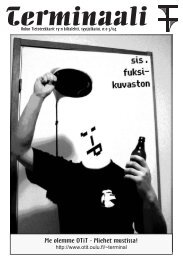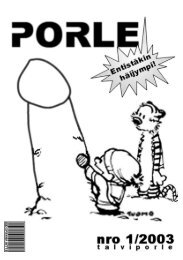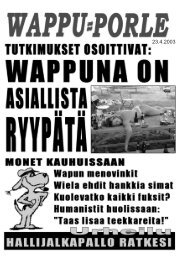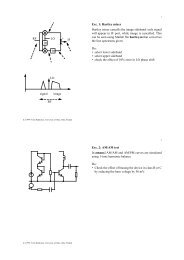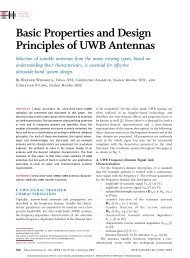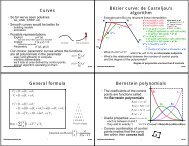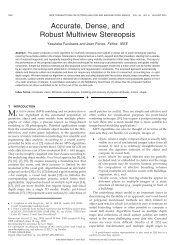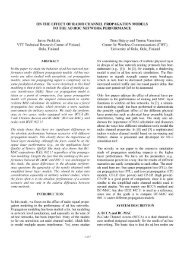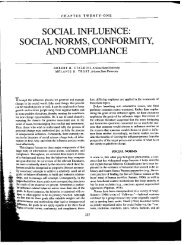Learning Vector Quantization in Footstep Identification - Oulu
Learning Vector Quantization in Footstep Identification - Oulu
Learning Vector Quantization in Footstep Identification - Oulu
You also want an ePaper? Increase the reach of your titles
YUMPU automatically turns print PDFs into web optimized ePapers that Google loves.
<strong>Learn<strong>in</strong>g</strong> <strong>Vector</strong> <strong>Quantization</strong> <strong>in</strong> <strong>Footstep</strong> <strong>Identification</strong><br />
ABSTRACT<br />
Susanna Pirttikangas, Jaakko Suutala, Jukka Riekki, and Juha Rön<strong>in</strong>g<br />
Intelligent Systems Group, Infotech <strong>Oulu</strong><br />
FIN-90014 University of <strong>Oulu</strong><br />
Susanna.Pirttikangas@oulu.fi<br />
This paper reports experiments on recogniz<strong>in</strong>g walkers<br />
from measurements with a pressure-sensitive floor,<br />
more specifically, a floor covered with EMFi material. A<br />
100 square meter pressure-sensitive floor (EMFi floor) was<br />
recently <strong>in</strong>stalled <strong>in</strong> the Intelligent Systems Group’s research<br />
laboratory at the University of <strong>Oulu</strong> as part of a<br />
smart liv<strong>in</strong>g room. The floor senses the changes <strong>in</strong> the pressure<br />
aga<strong>in</strong>st its surface and produces voltage signals of the<br />
event. The test set for footstep identification <strong>in</strong>cludes EMFi<br />
data from 11 walkers. The steps were extracted from the<br />
data and featurized. <strong>Identification</strong> was made with <strong>Learn<strong>in</strong>g</strong><br />
<strong>Vector</strong> <strong>Quantization</strong>. Discard<strong>in</strong>g a known error type <strong>in</strong> the<br />
measurements, the results show a 78 % overall success rate<br />
of footstep identification and are hence very promis<strong>in</strong>g.<br />
KEY WORDS<br />
Intelligent Environments, Personal Profil<strong>in</strong>g<br />
1 Introduction<br />
The research on <strong>in</strong>telligent environments [1], [2], [3] aims<br />
at mak<strong>in</strong>g smart houses, offices, tourist attractions etc.,<br />
where the environment learns and reacts to the behaviour of<br />
the occupants. The methodology can be applied <strong>in</strong> homes<br />
for the elderly and disabled as an enabl<strong>in</strong>g technology for<br />
monitor<strong>in</strong>g hazardous situations as well as <strong>in</strong> surveillance<br />
systems or <strong>in</strong> child care. Automatic recognition of the occupants<br />
without a need for wearable sensors leads to personal<br />
profil<strong>in</strong>g and enables smooth <strong>in</strong>teraction between the<br />
environment and the occupant.<br />
In this paper, experiments on recogniz<strong>in</strong>g walkers on<br />
a pressure-sensitive floor are described. The classification<br />
of footsteps was done with <strong>Learn<strong>in</strong>g</strong> <strong>Vector</strong> <strong>Quantization</strong>.<br />
The EMFi material <strong>in</strong>stalled under the laboratory floor dur<strong>in</strong>g<br />
the build<strong>in</strong>g stage was used <strong>in</strong> mak<strong>in</strong>g the measurements.<br />
The idea of us<strong>in</strong>g footsteps to identify persons is not<br />
new. Hidden Markov Models and Nearest-Neighbor classification<br />
have been used <strong>in</strong> recogniz<strong>in</strong>g walkers and applied<br />
<strong>in</strong> [4], and [5], respectively. The difference compared<br />
to our research is the utilization of dissimilar sensors<br />
that measure the vertical component of the ground reaction<br />
force caused by the weight and <strong>in</strong>ertial forces of the body.<br />
Furthermore, the other studies have had only small areas<br />
covered with sensors throughout the floor which is capable<br />
of measur<strong>in</strong>g the steps, while we have the whole floor area<br />
capable of measurement. In our <strong>in</strong>itial experiments, Hidden<br />
Markov Models were used <strong>in</strong> the identification [6], but<br />
<strong>in</strong> this paper, <strong>Learn<strong>in</strong>g</strong> <strong>Vector</strong> <strong>Quantization</strong> is used.<br />
In the next section, the EMFi material and the layout<br />
of the test<strong>in</strong>g area are <strong>in</strong>troduced. In section 3, the<br />
basic characteristics of <strong>Learn<strong>in</strong>g</strong> <strong>Vector</strong> <strong>Quantization</strong> are<br />
presented. The data set collected and the preprocess<strong>in</strong>g are<br />
described <strong>in</strong> section 4. The test results are presented <strong>in</strong><br />
section 5. F<strong>in</strong>ally, some conclusions are drawn and future<br />
work is clarified.<br />
2 EMFi Material<br />
ElectroMechanical Film [7] (EMFi) is a th<strong>in</strong>, flexible, lowprice<br />
electret material, which consists of cellular, biaxially<br />
oriented polypropylene film coated with metal electrodes.<br />
In the EMFi manufactur<strong>in</strong>g process, a special voided <strong>in</strong>ternal<br />
structure is created <strong>in</strong> the polypropylene layer, which<br />
makes it possible to store a large permanent charge <strong>in</strong> the<br />
film by the corona method, us<strong>in</strong>g electric fields that exceed<br />
the dielectric strength of EMFi. An external force affect<strong>in</strong>g<br />
the EMFi surface causes a change <strong>in</strong> the film’s thickness,<br />
result<strong>in</strong>g <strong>in</strong> a change <strong>in</strong> the charge between the conductive<br />
metal layers. This charge can then be detected as a voltage.<br />
EMFi is a F<strong>in</strong>nish <strong>in</strong>novation and a trademark of EMFiTech<br />
Ltd.<br />
EMFi material has been used for many commercial<br />
applications, such as keyboards, microphones <strong>in</strong> str<strong>in</strong>ged<br />
musical <strong>in</strong>struments and small and large area sensors. A<br />
F<strong>in</strong>nish company, Screentec Ltd, has developed vandalproof<br />
keyboards and keypads us<strong>in</strong>g EMFi foil protected<br />
by a steel or plastic plate. EMF Acoustics Ltd has produced<br />
EMFi-based microphones for different str<strong>in</strong>ged <strong>in</strong>struments,<br />
such as bass guitars, acoustic guitars and viol<strong>in</strong>s.<br />
EMFi material has been <strong>in</strong>stalled <strong>in</strong> the Intelligent<br />
Systems Group’s (ISG) research laboratory at the University<br />
of <strong>Oulu</strong>. The covered area is 100 square meters. The<br />
EMFi floor <strong>in</strong> the ISG laboratory is constructed of 30 vertical<br />
and 34 horizontal EMFi sensor stripes, 30 cm wide<br />
each, that are placed under the normal floor<strong>in</strong>g (see Figure<br />
1). The stripes make up a 30x34 matrix with a cell<br />
size of 30x30 cm. Instead of simply <strong>in</strong>stall<strong>in</strong>g squares of<br />
EMFi material under the floor<strong>in</strong>g, stripes were used, be-
Figure 1. The sett<strong>in</strong>g for EMFi sensor stripes under the<br />
laboratory’s normal floor<strong>in</strong>g.<br />
cause this layout requires clearly less wir<strong>in</strong>g. If squares<br />
were <strong>in</strong>stalled, the number of wires would be over a thousand.<br />
If a smaller room were to be covered with EMFi<br />
material, squares could be used. This would make it easier<br />
to determ<strong>in</strong>e the locations of the occupants <strong>in</strong> the room.<br />
Each of the 64 stripes produces a cont<strong>in</strong>uous signal<br />
that is sampled at a rate of 100Hz and streamed <strong>in</strong>to a PC,<br />
from where the data can be analyzed <strong>in</strong> order to detect and<br />
recognize the pressure events, such as footsteps, affect<strong>in</strong>g<br />
the floor. The analogous signal is processed with a National<br />
Instruments AD card, PCI-6033E, which conta<strong>in</strong>s an<br />
amplifier. It would be possible to <strong>in</strong>crease the sampl<strong>in</strong>g frequency<br />
up to ¢¡¤£¦¥ kHz, but 100Hz was considered adequate<br />
for this application.<br />
3 <strong>Learn<strong>in</strong>g</strong> <strong>Vector</strong> <strong>Quantization</strong><br />
<strong>Learn<strong>in</strong>g</strong> <strong>Vector</strong> <strong>Quantization</strong> (LVQ) [8] is a well known<br />
tool <strong>in</strong> various applications where statistical classification<br />
is needed such as texture analysis [9], speech recognition<br />
[10], and image analysis [11], to name a few. LVQ algorithms<br />
classify the data based on piecewise l<strong>in</strong>ear class<br />
boundaries, which are determ<strong>in</strong>ed by supervised learn<strong>in</strong>g.<br />
In this paper, the Optimized-<strong>Learn<strong>in</strong>g</strong>-Rate LVQ1<br />
(OLVQ1) was used, and it is briefly described. For more<br />
<strong>in</strong>formation on LVQ algorithms [8] is recommended.<br />
Consider the samples § derived from a f<strong>in</strong>ite set of<br />
classes ¨�©���� . In LVQ, a subset of codebook vectors are<br />
assigned to each class ©�� . Then, each § is set to belong to<br />
the same class as the closest (<strong>in</strong> Euclidean sense) codebook<br />
vector ��� . Let �����¢������������¨���� §������������ def<strong>in</strong>e the <strong>in</strong>dex<br />
of the nearest � � to § . The equations below def<strong>in</strong>e the basic<br />
LVQ1 algorithm.<br />
���������<br />
� ����� �<br />
� � �����<br />
��<br />
��<br />
��<br />
� ��� �<br />
§¦���<br />
� ������� �������<br />
� ��� �<br />
���<br />
���������<br />
���<br />
(1)<br />
(2)<br />
� ��� ������� §¦��� ��� � ���<br />
� �<br />
���<br />
� ��� � ��� ��� � for , (3)<br />
0.06<br />
0.05<br />
0.04<br />
0.03<br />
0.02<br />
0.01<br />
0<br />
−0.01<br />
−0.02<br />
−0.03<br />
0 5 10 15 20 25 30<br />
Figure 2. Raw EMFi data from one stripe. The x-axis represents<br />
time <strong>in</strong> seconds and the y-axis voltage.<br />
�<br />
�<br />
where , ����� and is the learn<strong>in</strong>g rate, which<br />
��������� �<br />
decreases with time. The algorithm m<strong>in</strong>imizes the rate of<br />
misclassification error by iteratively updat<strong>in</strong>g<br />
��<br />
the<br />
¢������¡�¡�¡<br />
codebook<br />
�����<br />
vectors at times . Eq. (1) § is � �<br />
used if and<br />
belong to the same class, and § Eq. � � (2) if and belong to<br />
different classes.<br />
In optimized LVQ1, attention is payed on<br />
�<br />
the learn<strong>in</strong>g<br />
rate , and it is determ<strong>in</strong>ed optimally for fastest �����<br />
convergence.<br />
To achieve this, the equations above are expressed<br />
as<br />
��<br />
��<br />
� ��� � � ���<br />
�<br />
������� §¦���<br />
������� ������� ������� �������<br />
� ���������<br />
�<br />
�<br />
���<br />
where if the classification is correct, ����� � and �����<br />
if the classification is wrong. Then, it can be shown �<br />
that<br />
the optimal learn<strong>in</strong>g rates are determ<strong>in</strong>ed by the recursion<br />
�<br />
�������<br />
�<br />
��<br />
���������<br />
�<br />
� � ����� �������<br />
In this work, the LVQ PAK [12] developed at the Faculty<br />
of Information Technology at Hels<strong>in</strong>ki University of<br />
Technology, was used for creat<strong>in</strong>g the codebook for classification.<br />
4 Data<br />
The data were collected <strong>in</strong> the spr<strong>in</strong>g 2003 and consist of<br />
the measurements of 11 persons walk<strong>in</strong>g on the pressuresensitive<br />
floor. The testees stepped on one particular stripe,<br />
and wore shoes. <strong>Footstep</strong>s targeted <strong>in</strong>to the cross<strong>in</strong>g of two<br />
stripes were collected as well. Furthermore, stepp<strong>in</strong>g with<br />
the right foot and the left foot were separated. Also, <strong>in</strong><br />
one test, footsteps without shoes were collected. All <strong>in</strong> all,<br />
about 60 footsteps were collected from each testee.<br />
Dur<strong>in</strong>g the test, all of the 64 EMFi stripes produce<br />
noisy data (see Figure 2, which shows the data recorded<br />
from one channel dur<strong>in</strong>g the test). The footsteps must<br />
be identified and segmentated from noisy channel data.<br />
��<br />
¡<br />
(4)<br />
(5)
0.08<br />
0.06<br />
0.04<br />
0.02<br />
0<br />
−0.02<br />
−0.04<br />
0 20 40 60 80 100 120 140 160 180<br />
Person 4<br />
0.08<br />
0.06<br />
0.04<br />
0.02<br />
0<br />
−0.02<br />
Figure 3. A good-quality step.<br />
−0.04<br />
0 20 40 60 80 100 120 140 160 180<br />
Person 7<br />
Figure 4. A footstep that hits ma<strong>in</strong>ly on one stripe, but a<br />
small fraction of the step affects the measurements of an<br />
adjacent channel.<br />
The segmentation problem is be<strong>in</strong>g studied <strong>in</strong> a different<br />
project. The amplitude of a step is very large compared to<br />
signal noise variance, and no filter<strong>in</strong>g of the noise is therefore<br />
needed.<br />
Different problems arise <strong>in</strong> f<strong>in</strong>d<strong>in</strong>g “good-quality”<br />
steps for modell<strong>in</strong>g. In Figures 3, 4, 5, and 6 different situations<br />
occurr<strong>in</strong>g while walk<strong>in</strong>g are presented. In these<br />
figures, the measurements from three adjacent channels are<br />
shown.<br />
In Figure 3, a good-quality step is shown. The step<br />
is hit on the center of one stripe. The footstep <strong>in</strong> Figure<br />
4 is targeted mostly onto one stripe, but a small amount<br />
of the step is hit on another stripe. In Figure 5, the center<br />
of the footstep (between the ball and the heel of the foot)<br />
has hit the cross<strong>in</strong>g of the two stripes. In Figure 6, several<br />
successive footsteps are hit on one stripe. In other words,<br />
0.07<br />
0.06<br />
0.05<br />
0.04<br />
0.03<br />
0.02<br />
0.01<br />
0<br />
−0.01<br />
−0.02<br />
0 20 40 60 80 100<br />
Person 4<br />
120 140 160 180 200<br />
Figure 5. A footstep <strong>in</strong> the cross<strong>in</strong>g of two stripes.<br />
this is the situation when a person walks along one stripe.<br />
From Figure 6, it can be seen that <strong>in</strong> this case the resett<strong>in</strong>g<br />
time of the EMFi floor causes the steps to blur <strong>in</strong>to each<br />
other, and they cannot be used <strong>in</strong> model<strong>in</strong>g.<br />
The problems mentioned earlier affect the selection of<br />
the signal segmentation algorithm. In this <strong>in</strong>itial phase, raw<br />
segmentation was made with hybrid-median filters [13].<br />
The steps depicted <strong>in</strong> Figure 6 were rejected, and for the<br />
other cases, footsteps were generated by summ<strong>in</strong>g the measurements<br />
from adjacent channels to obta<strong>in</strong> the whole footstep.<br />
The data was divided <strong>in</strong>to a tra<strong>in</strong><strong>in</strong>g set and a test set.<br />
In this classification experiment, the footsteps from both<br />
left and right foot were used. The tra<strong>in</strong><strong>in</strong>g set consisted of<br />
272 footsteps (around 20-26 examples for each class), and<br />
the test set consisted 131 footsteps.<br />
For feature selection, the footsteps were divided <strong>in</strong>to<br />
two sections: the ball of the footstep and the heel of the<br />
footstep. The partition was made accord<strong>in</strong>g to the local<br />
m<strong>in</strong>imum �¡ £¢��¥¤<br />
package LNKnet [14] developed at MIT L<strong>in</strong>coln Laboratory<br />
was used <strong>in</strong> feature selection. Several features were<br />
derived from footstep data (<strong>in</strong>clud<strong>in</strong>g spatial and frequency<br />
doma<strong>in</strong> features), and they were tested with the kNN- classifier<br />
<strong>in</strong> LNKnet.<br />
�§¦<br />
¢��¨¤<br />
� , as shown <strong>in</strong> Figure 7. A software<br />
�©�������� ���¤��<br />
�©������§� £¢��¥¤<br />
�¢��¨¤ £¢��¨�<br />
�¢������<br />
The features chosen for classification are the length<br />
from to , the amplitude means and standard<br />
deviations for the ball of the foot (from to ),<br />
and for the heel of the foot (from to ). Furthermore,<br />
the coord<strong>in</strong>ate po<strong>in</strong>ts ( , ¦<br />
�¢��¨¤ ¢������ ), ( ,<br />
age �<br />
�<br />
¦<br />
), ( �¢������ , ¢��¨¤ ¦<br />
), the amplitude ¢������ ¦<br />
¦<br />
¦<br />
¦<br />
¦<br />
¢������ �<br />
¢��¨¤<br />
�<br />
���<br />
¢������ �<br />
¢��¥¤<br />
, and an aver-<br />
� �¡�¢�<br />
��¤��<br />
were chosen.
−0.01<br />
−0.02<br />
−0.03<br />
−0.04<br />
y<br />
0.04<br />
0.03<br />
0.02<br />
0.01<br />
0<br />
P1 P2 P3 P4 P5 P6 P7 P8 P9 P10 P11<br />
P1 84.62 8.34 38.10 0.00 0.00 9.09 0.00 0.00 0.00 0.00 0.00<br />
P2 7.69 83.33 9.52 0.00 0.00 0.00 0.00 0.00 0.00 0.00 0.00<br />
P3 0.00 0.00 33.33 0.00 0.00 0.00 0.00 25.00 0.00 0.00 0.00<br />
P4 0.00 0.00 0.00 91.67 0.00 0.00 16.67 0.00 0.00 8.33 0.00<br />
P5 0.00 0.00 0.00 8.33 69.23 9.09 25.00 0.00 0.00 0.00 0.00<br />
P6 0.00 0.00 0.00 0.00 0.00 72.73 8.33 0.00 0.00 16.67 0.00<br />
P7 0.00 0.00 0.00 0.00 7.69 0.00 25.00 8.33 0.00 8.33 25.00<br />
P8 0.00 8.34 19.05 0.00 15.39 0.00 0.00 66.67 10.00 0.00 0.00<br />
P9 7.69 0.00 0.00 0.00 0.00 0.00 25.00 0.00 90.00 8.33 0.00<br />
P10 0.00 0.00 0.00 0.00 0.00 0.00 0.00 0.00 0.00 58.33 8.33<br />
P11 0.00 0.00 0.00 0.00 7.69 9.09 0.00 0.00 0.00 0.00 66.67<br />
750 800 850 900 950 1000 1050 1100 1150<br />
Figure 6. Several successive footsteps on one stripe.<br />
0.08<br />
0.06<br />
0.04<br />
0.02<br />
0<br />
−0.02<br />
[x start ,0]<br />
[x max1 ,y max1 ]<br />
[x m<strong>in</strong> ,y m<strong>in</strong> ]<br />
−0.04<br />
0 10 20 30 40 50<br />
x<br />
60 70 80 90 100<br />
Table 1. Confusion matrix for the eleven persons’ footsteps.<br />
[x max2 ,y max2 ]<br />
[x mid ,0]<br />
[x end ,y end ]<br />
Figure 7. The features derived from each footstep.<br />
5 Test Results<br />
The best results were obta<strong>in</strong>ed with a codebook size of 60.<br />
The OLVQ1 was run for 100 iterations, and the LVQ1 for<br />
1000 iterations. The results are presented <strong>in</strong> Table 1. There<br />
is notable confusion <strong>in</strong> the footsteps of the persons number<br />
3, 7, and 10. The overall recognition accuracy is ¥�¥¡<br />
In Figure 4, the footstep from testee number 7 is<br />
shown. The footstep <strong>in</strong> Figure 4 has not completely hit<br />
only one stripe, but <strong>in</strong> a small extent it reaches the adjacent<br />
stripe as well. In study<strong>in</strong>g the results, it was noticed,<br />
that almost all footsteps from the poorly identified walkers<br />
were of the same k<strong>in</strong>d. Classification was successful for<br />
the footsteps alike the one shown <strong>in</strong> Figure 5.<br />
Therefore, the reason for the badly identified walkers<br />
is <strong>in</strong> the summ<strong>in</strong>g process made before classification.<br />
The measurements from adjacent channels were summed<br />
to achieve the whole footstep. The summ<strong>in</strong>g works, if the<br />
step is hit <strong>in</strong> the center of the two stripes. If only a small<br />
part of the step hits on the other stripe, the summ<strong>in</strong>g affects<br />
the coord<strong>in</strong>ate po<strong>in</strong>ts of the maximum to change <strong>in</strong>to<br />
another location, and <strong>in</strong> this case, the classification is not<br />
reliable. If these situations are ignored, the overall recognition<br />
accuracy ¢¤£ is .<br />
6 Conclusions<br />
In this paper, experiments on identify<strong>in</strong>g persons based on<br />
their footsteps on an EMFi floor were reported. The results<br />
are very promis<strong>in</strong>g, but there are still unanswered questions.<br />
In this phase, the basic tools for us<strong>in</strong>g the EMFi floor<br />
are be<strong>in</strong>g developed.<br />
The features chosen for modell<strong>in</strong>g seem to capture<br />
the signal characteristics, but the summation of the measurements<br />
from adjacent channels is not the solution for<br />
produc<strong>in</strong>g the whole footstep. The summation works, if<br />
the step is divided evenly between two stripes. This way,<br />
the chosen features, such as coord<strong>in</strong>ate po<strong>in</strong>ts for the maximum,<br />
are not confused. If there is only a small fraction,<br />
that hits the other stripe, the summation worsen the clas-<br />
.
sification results. It is possible to divide the footsteps <strong>in</strong>to<br />
good-quality steps and <strong>in</strong>to bad-quality steps based on reasons<br />
mentioned above. The misbehaved footsteps can be<br />
either ignored or sensor fusion can be used <strong>in</strong> footstep reconstruction.<br />
If the badly formulated footsteps are cleared<br />
from the test set, an 78 % overall recognition rate can be<br />
achieved.<br />
Naturally, this research aims at real-time learn<strong>in</strong>g and<br />
identification. The goal is to f<strong>in</strong>d a way to learn the footsteps<br />
from a person immediately one walks <strong>in</strong>to the room.<br />
Furthermore, the person needs to be identified from the first<br />
steps he produces on the floor.<br />
The problem of identification will be even more difficult<br />
with several persons walk<strong>in</strong>g <strong>in</strong> the room at the same<br />
time. This requires a methodology for track<strong>in</strong>g objects on<br />
the floor, and this will be studied <strong>in</strong> a different sett<strong>in</strong>g later<br />
on.<br />
Acknowledgments<br />
This work was funded by TEKES and Academy of F<strong>in</strong>land.<br />
The authors would like to thank Kalle Koho for his work on<br />
signal segmentation and EMFi data collection.<br />
References<br />
[1] I. A. Essa. Ubiquitous sens<strong>in</strong>g for smart and aware<br />
environments: Technologies towards the build<strong>in</strong>g of<br />
an aware home. IEEE Personal Communications, October<br />
2000. Special issue on network<strong>in</strong>g the physical<br />
world.<br />
[2] MIT’s oxygen project. http://oxygen.lcs.mit.edu/.<br />
Available 12.4.2003.<br />
[3] Aware home. http://www.cc.gatech.edu/fce/ahri/.<br />
Available 22.1.2003.<br />
[4] M.D. Addlesee, A. Jones, F. Livesey, and F. Samaria.<br />
ORL active floor. IEEE Personal Communications,<br />
4(5), 1997, 35–41.<br />
[5] R.J. Orr and G.D. Abowd. The smart floor: A mechanism<br />
for natural user identification and track<strong>in</strong>g. In<br />
Proc. 2000 Conf. Human Factors <strong>in</strong> Comput<strong>in</strong>g Systems<br />
(CHI 2000), New York, USA, 2000.<br />
[6] S. Pirttikangas, J. Suutala, J. Riekki, and J. Rön<strong>in</strong>g.<br />
<strong>Footstep</strong> identification from pressure signals us<strong>in</strong>g<br />
Hidden Markov Models. In Proc. F<strong>in</strong>nish Signal Process<strong>in</strong>g<br />
Symposium (FINSIG’03), Tampere, F<strong>in</strong>land,<br />
2003, 124–128.<br />
[7] M. Paajanen, J. Lekkala, and K. Kirjava<strong>in</strong>en. Electromechanical<br />
film (EMFi) - a new multipurpose electret<br />
material. Sensors and actuators A, 84, 2000, 1–2.<br />
[8] T. Kohonen. Self-Organiz<strong>in</strong>g Maps. (New York,<br />
Spr<strong>in</strong>ger-Verlag Berl<strong>in</strong> Heidelberg, 1997).<br />
[9] S. Livens, P. Scheunders, G. Van de Wouwer, D. Van<br />
Dyck, H. Smets, J. W<strong>in</strong>kelmans, and W. Bogaerts.<br />
LVQ classification of corrosion images from wavelet<br />
features. In Proc. Tr<strong>in</strong>ocular Jo<strong>in</strong>t Meet<strong>in</strong>g on Electron<br />
Microscopies, 1995.<br />
[10] A. Duchon and S. Katagiri. A m<strong>in</strong>imum-distortion<br />
segmentation/LVQ hybrid algorithm for speech segmentation.<br />
Journal of the Acoustical Society of Japan<br />
(Eng.), 14(1), 1993, 37–42.<br />
[11] K.-S. Cheng, R. Sun, and N.-H. Chow. Cancerous<br />
liver tissue differentiation us<strong>in</strong>g LVQ. In Proc. 1st<br />
Int. Conf. Artificial Neural Networks <strong>in</strong> Medic<strong>in</strong>e and<br />
Biology, (ANNIMAB-1), 2002.<br />
[12] T. Kohonen, J. Hynn<strong>in</strong>en, J. Kangas, J. Laaksonen,<br />
and K. Torkkola. LVQ PAK: The learn<strong>in</strong>g vector<br />
quantization program package. Technical report,<br />
Hels<strong>in</strong>ki University of Technology, 1996. Report<br />
A30.<br />
[13] P. He<strong>in</strong>onen and Y. Neuvo. FIR-median hybrid filters.<br />
IEEE Trans. Acoust., Speech, Signal Process<strong>in</strong>g,<br />
ASSAP-35(6), 1987, 832–838.<br />
[14] L. Kukolich and R. Lippmann. LNKnet User’s<br />
Guide. Massachusetts Institute of Technology,<br />
L<strong>in</strong>coln Laboratory, August 1999.<br />
http://www.ll.mit.edu/IST/lnknet/ Available on<br />
29.4.2003.




